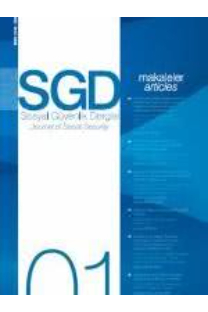İşletmelerde güvenlik kültürünün oluşumunda yönetimin rolü ve önemi
The ımportance and the role of the management to create the safety culture on the companies
___
- Akalp, G., S. Aytaç (2005), İş Sağlığı ve Güvenliği Açısından Güvenlik Kültürü Oluşumu ve Bir Uygulama, IV. Uluslararası İş Sağlığı ve Güvenliği Konferansı (Bildiri), Ankara.
- Aytaç, S. (2011), İş Kazalarını Önlemede Güvenlik Kültürünün Önemi, Türk Metal Dergisi, Kasım.
- Aytaç, S., Dursun S. (2011), The Effect of Safety Culture on Safety Behavior and Accidents, XIX World Congress on Safety and Health at Work, September 11-15, 2011, Halic Congress Center, İstanbul, http://safety2011turkey.org/.
- Bozkurt, V. (2005), Değişen Dünyada Sosyoloji, 3, Aktüel Yayınları, İstanbul.
- Cooper, M. D. (1998), Improving Safety Culture: A Practical Guide (Improving), John Wiley & Sons, Chichester.
- Cox S., Flin, R. (1998), Safety Culture: Philosophers Stone or Man of Straw?, Work and Stress, 12(3), pp 189-201.
- Demirbilek, T. (2005), İş Güvenliği Kültürü, Legal Yayınları, İzmir.
- Dursun, S. (2012), İş Güvenliği Kültürü, Beta Yayınları, İstanbul.
- Dursun, S. (2011), Güvenlik Kültürünün Güvenlik Performansı Üzerine Etkisine Yönelik Bir Uygulama, Yayınlanmamış Doktora Tezi, Uludağ Üniversitesi Sosyal Bilimler Enstitüsü Çalışma Ekonomisi ve Endüstri İlişkileri Anabilim Dalı, Yönetim ve Çalışma Psikolojisi Bilim Dalı, Bursa.
- Dursun S., Aytaç S. (2011), The Effect of Safety Culture on Safety in an Organizational Structure: A Case Study in Turkey, 10th International Symposium on Human Factors in Organisational Design and Management (ODAM 2011) 4-6 April 2011, Rhodes University, Grahamstown, Eastern Cape, South Africa, http://www. odam2011.net.
- Flin R. (2007), Measuring Safety Culture in Healthcare: A Case for Accurate Diagnosis, Safety Science, Volume 45, Issue 6, July 2007, pp 653667.
- Hoffman, D., Stetzer,A. (1998), The Role of Safety Climate and Communication in Accident Interpretation: Implications for Learning from Negative eEents Academy of Management Journal, 1998, Vol. 41, No. 6, pp 644-657.
- Hoffman, D., Stetzer, A. (1996), A Cross-Level Investigation of Factors Influencing Unsafe Behaviors and Accidents, Personel Psychology, Vol 49.
- IAEA 1991, Safety Culture, International Safety Advisory Group, Safety Series, 75-INSAG-4 (Vienna: IAEA).
- Kroeber, A. L., Kluckhohn, C. (1952), Culture: A Critical Review of Concepts and Definitions Harvard University Peabody Museum of American Archeology and Ethnology Papers 47.
- Muniz, Beatriz F., J. M. M. Peon, C.J.V. Ordas (2007), Safety Culture: Analysis of the Causal Relationships Between İts Key Dimensions, Journal of Safety Research, 38, pp 627-641.
- Neal, A., M. A. Griffin (2006), A Study of the Lagged Relationships Among Safety Climate Safety Motivation, Safety Behavior, and Accidents at the Individual and Group Levels, Journal of Applied Psychology, Copyright 2006, by the American Psychological Association 2006, Vol. 91, No. 4, pp 946-953.
- Neal A., M. A. Griffin, P.M. Hart (2000), The Impact of Organizational Climate on Safety Climate and Individual Behaviour, Safety Science, pp 99109.
- Ülgen S., İ. Or, H. Saygın, G. Kumbaroğlu, İ. Atiyas, Nükleer Enerjiye Geçişte Türkiye Modeli http://www.edam. org.tr/document/edamnukleerrapor.pdf (18.06.2013).
- Reason, J. (2000), Safety Pradoxes and Safety Culture, Injury Control & Safety Promotion, Vol. 7 No:1.
- T.C. Cumhurbaşkanlığı Devlet Denetleme Kurulu, Tersanecilik Sektörü ile İş Sağlığı ve Güvenliği Açısından Tuzla Tersaneler Bölgesinin İncelenmesi ve Değerlendirilmesi Raporu, http://www. tccb.gov.tr/ddk/ddk25.pdf (21.06.2013).
- Ülgen S., İ. Or, H. Saygın, G. Kumbaroğlu, İ. Atiyas (2011), Nükleer Enerjiye Geçişte Türkiye Modeli, http://www.edam.org.tr/document/ edamnukleerrapor.pdf (18.06.2013).
- http://www.academia.edu/1951057/ Calisma_Hayatinda_Saglik_ve_ Guvenlik_Kulturu (12.01.2013).
- h t t p : / / w w w. t u i k . g o v. t r / G o s t e rg e . do?metod=GostergeListe&alt_id=3 (03.01.2013).
- http://www.madenciyim.com/forums/ showthread.php?4264-G%FCvenlik- K%FClt%FCr%FC (24.06.2013).
- http://www.elyadal.org/pivolka/10/ PiVOLKA_10_01.pdf (20.06.2013).
- h t t p : / / w w w. r e s m i g a z e t e . g o v. t r / eskiler/2013/05/20130515-1.htm (21.05.2013).
- ISSN: 2146-4839
- Yayın Aralığı: 2
- Başlangıç: 2011
- Yayıncı: SOSYAL GÜVENLİK KURUMU
Mete Kaan NAMAL, Soner KARATAŞOĞLU, Yunus KÖLEOĞLU
Toplum yararına çalışma programı: İşsizlikle mücadelede yeni bir yöntem mi?
İşletmelerde güvenlik kültürünün oluşumunda yönetimin rolü ve önemi
Gizem AKALP, NURETTİN YAMANKARADENİZ
Türkiye'de sosyal güvenlik sisteminin kurum ve kapsam olarak gelişimi ve sosyal güvenlik adaleti
İş güvenliği kültürünün çalışanların güvenli davranışları üzerine etkisi
